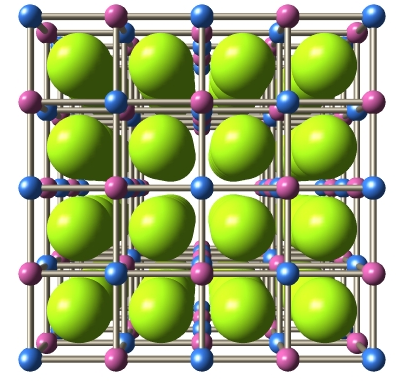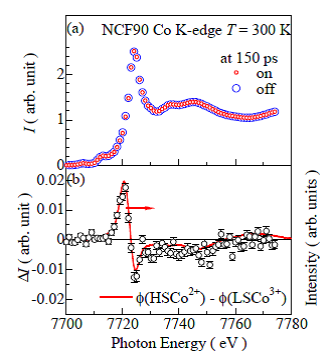Press Release
New magnetic state obtained by photoexcitation
March 7, 2013
University of Tsukuba
High Energy Accelerator Research Organization (KEK)
Prof. Yutaka Moritomo’s group at the Faculty of Pure and Applied Sciences, University of Tsukuba, together with Prof. Shin-ichi Adachi and his colleagues at the Institute of Materials Structure Science, High Energy Accelerator Research Organization (KEK), found that a thin film of the cobalt Prussian blue analogue Na0.79Co[Fe(CN)6]0.902.9H2O (NCF90), which does not show phase transition with heat, can be photoexcited using a femtosecond laser and that the lifetime of the large spin Co2+ is extremely long at 32 ns. Such a long lifetime strongly indicates the formation of a new magnetic state (metastable state).
The structure of Prussian blue analogues (AxM[Fe(CN)6]yzH2O; where A is an alkaline metal and M, a transition metal) is a host lattice of transition metals with guest alkali metal ions (Fig. 1); the alkali metal ions can be electrochemically controlled. These analogues have been employed in the past as pigments (Prussian blue) and have recently been considered as promising electrochromic materials as well as promising candidates for cesium removal and secondary battery cathode applications. The research group photoexcited a thin film of NCF90, which does not show phase transition with temperature, using a femtosecond laser and then used time-resolved X-ray absorption spectroscopy near the Co K absorption edge with NW14A at the Photon Factory, KEK. High-spin Co2+ formed by photoexcitation, and the concentration of this high-spin Co2+ (0.007/Co) was approximately the same as the excited photon density (0.005/Co). Moreover, the rise time of high-spin Co2+ is less than the equipment resolution (100 ps) whereas its lifetime is 32 ns (Fig. 2).
Past research has showed that photoexcitation of the NCF90 film using a femtosecond laser slightly increases the lattice parameter by 0.05%. The rise time of the lattice parameter increase is less than the equipment resolution of 100 ps, and the lifetime is at least 1 ns. These results show that the metastable state in cobalt Prussian blue analogues is a state where “the lattice is isotropically widened and high-spin Co2+ impurity is present at a low concentration”.
Cobalt Prussian blue analogues can be potentially applied to optical switch materials in the future, for which, greater understanding of the phase transition dynamics within the timeframe of the X-ray pulse width of 100 ps is required.
This result was chosen as the Editor’s Choice for the March 2013 issue of the Journal of the Physical Society of Japan (JPSJ), a journal in English published by the Physical Society of Japan (JPS).

Fig. 1: Schematic of a Prussian blue analogue. Transition metals bridged by cyano ligands form the host lattice. Interstices of the host lattice are occupied by guest alkali metal ions.

Fig. 2: (a) X-ray absorption spectrum near the Co K absorption edge with photoemission on and off. (b) X-ray absorption spectrum difference (○). The solid line represents the X-ray absorption spectrum difference between high-spin Co2+ (Φ(HSCo2+)) and low-spin Co3+ (Φ(HSCo3+)) X-ray absorption spectra.
Media Contact
Faculty of Pure and Applied Sciences, University of Tsukuba
Prof. Yutaka Moritomo
Public Relations Office, High Energy Accelerator Research Organization (KEK), Japan
TEL: +81-29-879-6047
FAX: +81-29-879-6049
E-mail: press@kek.jp